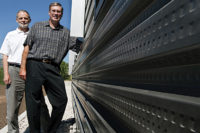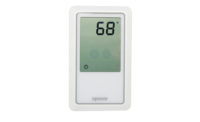Radiant cooling is coming in from the great wide-open.
While atriums and expansive open spaces of commercial buildings remain the bread-and-butter for engineers and radiant cooling manufacturers, other areas such as office spaces and classrooms are now opportunities for these systems, according to Devin Abellon, P.E., Uponor’s business development manager of engineering services.
“We have seen a lot of examples of radiant cooling systems in spaces like lobbies,” he notes. “We’ve also seen instances where its application has been limited to climates with low-relative humidity. But, as we see the industry evolve and get more experienced in how these systems actually work, a lot of the preconceived notions and reservations that have held radiant cooling systems back are starting to go away.”
Abellon says the room for growth with radiant cooling systems is immense as education and the growing focus on thermal human comfort continues.
“As the engineering community better understands how radiant systems can be utilized as the base, it will grow as a sensible cooling source,” he states.
Adam Botts, a product engineer with Viega, notes there have been many studies conducted on traditional HVAC systems vs. radiant heating and cooling in the past years and the data the company is seeing now is going to shape the future of radiant cooling design.
“These studies take a long time, they last for years to get (specific) climate information,” he explains. “We’re gathering information from hundreds of buildings that have cooling systems in them and comparing that to the decades of data for all types of climate-controlled buildings, with forced air being the main one.”
Botts notes the slow process of radiant cooling gaining acceptance is much like other technologies that have grabbed a foothold.
“I compare it to solar electric,” he says. “There are early adopters who are concerned about energy efficiency. Over time, you have more adopters that make it more widely practiced and then you get to a sales volume where it works for other people. Then it makes more financial sense overall.”
Climate neutral
Abellon explains radiant cooling systems can be used in any climate, so long as the engineer is able to effectively manage the indoor relative humidity.
“Once we start looking more closely at what, as system designers, we are bound to do, regardless of whether or not we have a radiant system, we recognize the importance of creating the proper indoor environment by maintaining conditions that have both moderate temperatures and relative humidity within the guidelines of ASHRAE Standard 55,” he notes.
Uponor believes the push of human physiology and thermal comfort studies and understanding them will help make radiant cooling applications become more accepted for commercial spaces.
“As there is more awareness about how to make occupants more comfortable and we see the trend about human comfort and designing buildings that people get excited about occupying, that will allow radiant many more opportunities,” says Aaron Stotko, an Uponor manager for the commercial segment.
Abellon adds: “Engineers have become savvier with how they’re managing the indoor environment. It’s not just the temperature, but all the aspects of human thermal comfort. Radiant cooling systems speak to that and provide a better opportunity to create a more inviting indoor environment.”
Materials on hand
Available on a strictly beta basis in the U.S., where Aquatherm has to approve its use on a case-by-case basis, the company has its singular radiant heating and cooling system, the Aquatherm Black System.
Aquatherm Black can be specified for a free-floating ceiling, dry-constructed walls, plaster walls and metal ceilings. The polypropylene-random grid panels are custom-made for each application and offer the benefit of being connected by heat fusion, which can reduce leakage risks.
Aquatherm North America Vice President of Marketing Barry Campbell notes the system is prevalent throughout Europe and he sees a potential growing market in the U.S. He adds testing and field research are critical for radiant heating and cooling products at Aquatherm.
“If you’re doing a system behind a wall or beneath the floor or in a ceiling, you’re always worried about the penetration factor and you also need to account for humidity and other issues,” Campbell says. “So those types of considerations are at the forefront for us.”
Recently, during a project at a track-and-field stadium in Belarus, Aquatherm studied how deep the point of a javelin goes into ground so its radiant product wouldn’t be damaged. This and other issues encompass what the manufacturer has to think about in regard to the Aquatherm Black System and the Aquatherm Blue Pipe System, a more traditional tubing product that comes in 1/2-in. through 24-in. diameters.
Abellon notes there is a growing educational element to radiant cooling, with more focus to the technology shown from ASHRAE at its conference held in conjunction with the AHR Expo and other industry organizations. But there also are other opportunities to learn how to effectively incorporate radiant cooling as part of an energy-efficient design solution.
“As an industry, Uponor and other manufacturers have done a nice job of providing engineers with better resources,” he says. “At Uponor, we have our Engineer Resource Center that has information they would need, including case studies, specification and sizing tools available. We also have our Radiant Cooling Design Manual.
“We pride ourselves on the fact that we are not just selling system components. We are working hand-in-hand with the engineers to provide them with those project-specific resources for planning, design and implementation.”
Radiant controls
Botts says the control strategies for radiant cooling designs have become interesting, especially for commercial projects and high-mass systems.
“On the product level the ability to cool a surface is just as straightforward as heating one in terms of delivering thermal energy,” he states. “But to be able to look at the array of functional control strategies and building modifications that can lead to greater efficiencies is interesting.”
Botts notes these strategies include designs that require continuous operation of massive slabs at high-water temperatures or having a thermal mass preloading strategy that takes advantage of a utility’s time-of-use rate structure.
“With that design, you can cool in the morning and thermal mass will release cooling for the occupants the rest of the day,” he says. “Then you don’t have any energy running in terms of cooling for the majority of the day.”
The latest option Botts has seen is a pulse output where a radiant cooling system is running intermittingly for only a few minutes at a time.
“This design replaces the dormant water in the system with another set of cool water,” he states. “Then that water’s thermal energy migrates through the slab, keeping the same level of comfort.
“All these designs have different efficiencies based on the climate and the utility rate structure.”
Stotko and Abellon note it also is important for the engineer and architect to go beyond the coordination of pipe chases and manifold placement. Radiant cooling design requires also working with the project’s structural engineer on slab details and more.
“You’re not just looking at getting to a setpoint temperature, you’re looking at creating an indoor environment to function within that space,” Abellon says. “You have to understand things such as insulation and flooring. They could have a tremendous effect on how a system operates. It’s a different approach to how you’re constructing buildings.”
Stotko adds: “If more of the stakeholders come together early on in the project and don’t pass the project on from trade to trade, that gives radiant cooling a better chance in buildings.”
Abellon and Stotko make it clear developing a commercial radiant cooling system isn’t something that should overwhelm an engineer, but crafting a strong team of principals throughout the project is critical to a successful system design.
“Radiant cooling systems are not new per se, and they are not overly difficult,” Abellon says. “It’s just a different approach and mindset on how to create a comfortable environment. The engineer needs to have a team that provides, experience, guidance and support.”
This article was originally titled “Chilling sensation” in the March 2018 print edition of PM Engineer.






